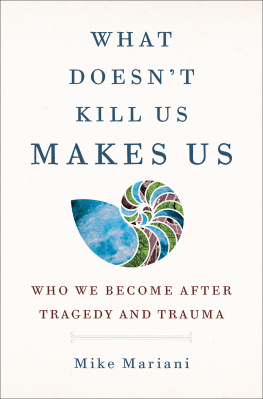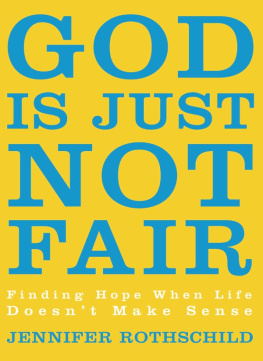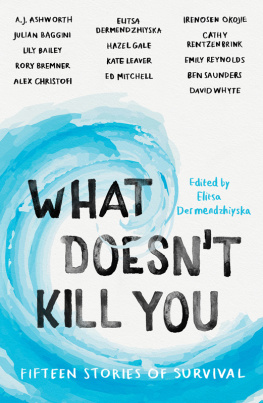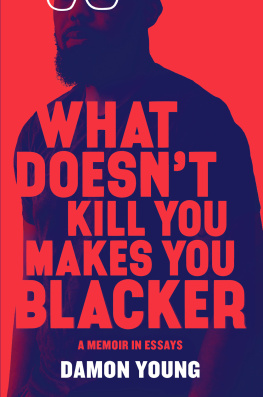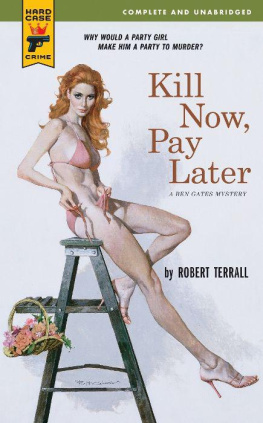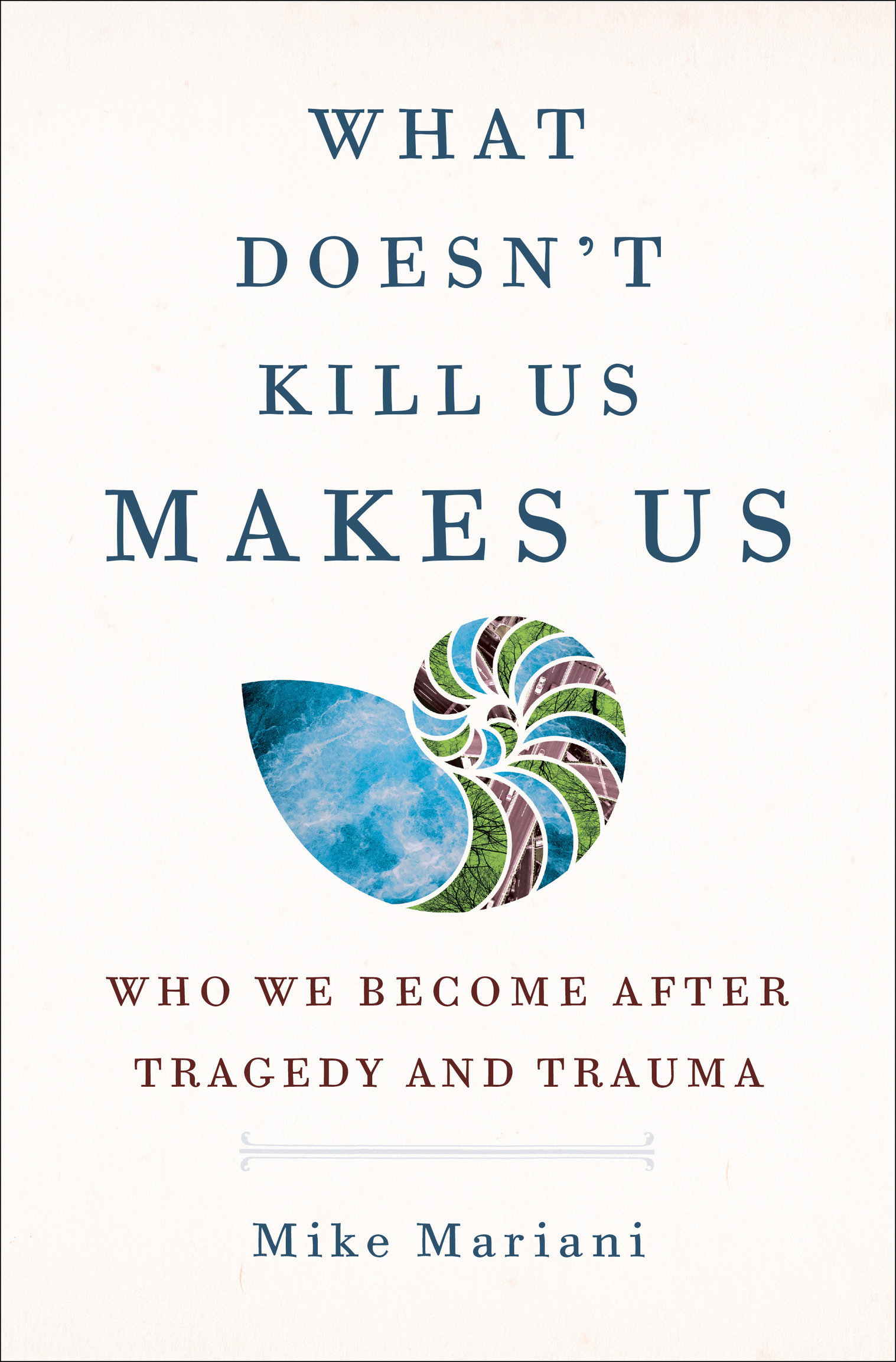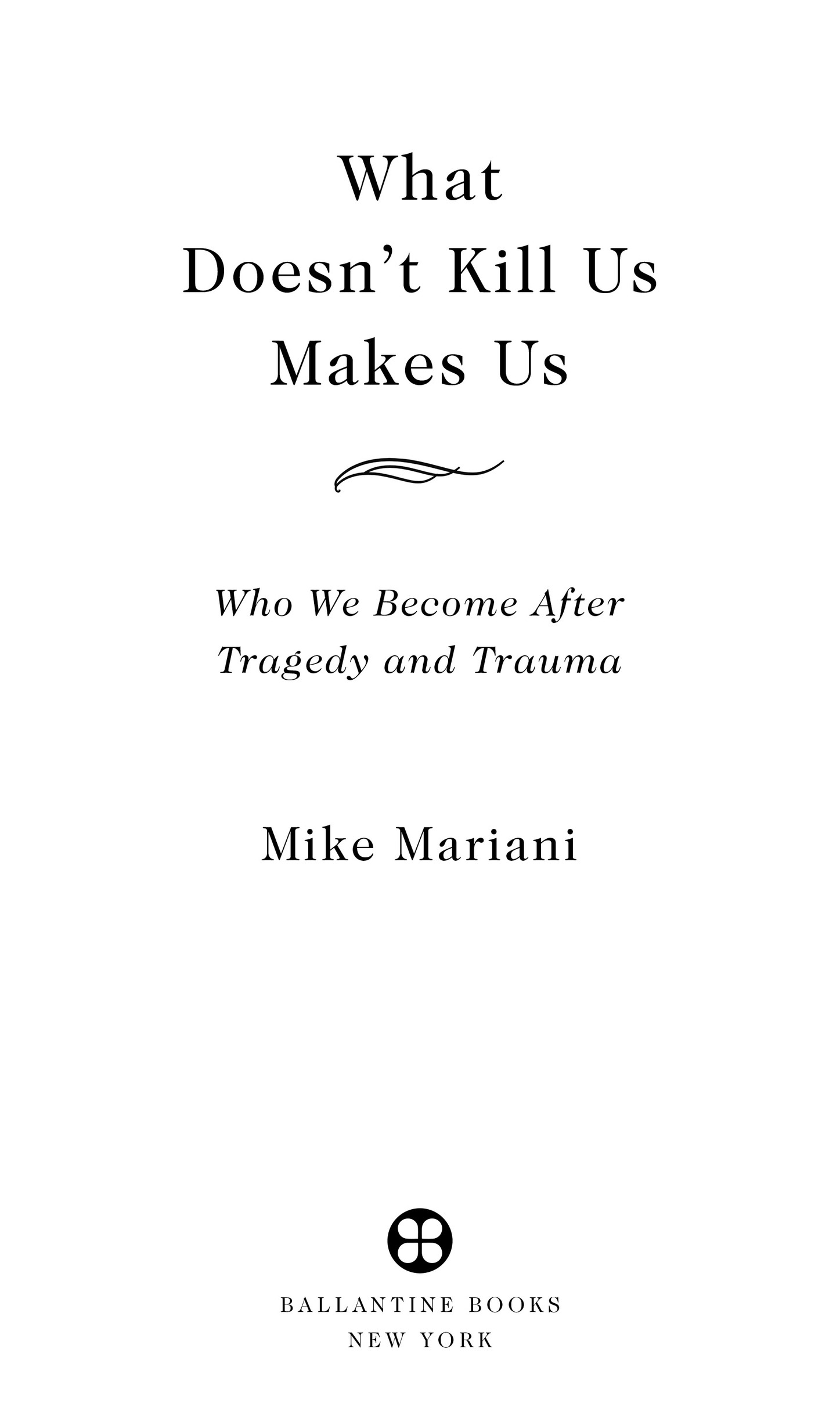Contents
Landmarks
Print Page List
What Doesnt Kill Us Makes Us is a work of nonfiction. Some names and identifying details have been changed.
Copyright 2022 by Michael Mariani
All rights reserved.
Published in the United States by Ballantine Books, an imprint of Random House, a division of Penguin Random House LLC, New York.
Ballantine is a registered trademark and the colophon is a trademark of Penguin Random House LLC.
Library of Congress Cataloging-in-Publication Data
Names: Mariani, Mike, author.
Title: What doesnt kill us makes us: who we become after tragedy and trauma / Mike Mariani.
Identifiers: LCCN 2021041264 (print) | LCCN 2021041265 (ebook) | ISBN 9780593236949 (hardcover) | ISBN 9780593236956 (ebook)
Subjects: LCSH: Life change events. | Psychic trauma. | Adjustment (Psychology)
Classification: LCC BF637.L53 M367 2022 (print) | LCC BF637.L53 (ebook) | DDC 155.9/3dc23/eng/20211025
LC record available at https://lccn.loc.gov/2021041264
LC ebook record available at https://lccn.loc.gov/2021041265
Ebook ISBN9780593236956
randomhousebooks.com
Cover design: Emily Mahon
Cover images: Shutterstock (nautilus, highway, textured background), Adrien Olichon/Unsplash (ocean), Yoksel Zok/Unsplash (trees)
ep_prh_6.0_140788410_c0_r0
Contents
What makes Heroic? To face simultaneously ones greatest suffering and ones highest hope.
Friedrich Nietzsche, The Gay Science
Im a hero. Its easy to be a hero. If you dont have hands or feet, youre either a hero or dead.
Rubn Gallego, White on Black
Introduction
Invisible Kingdoms
Out of lifes school of warwhat doesnt kill me, makes me stronger.
I ve known about Friedrich Nietzsches lean, bracing maxim since high school, perhaps even earlier. At once a dream of invincibility and a promise to avenge oneself against misfortune, the aphorism was stitched into the cultural fabric all around me; commemorated in songs, slogans, tattoos, and social media posts; exchanged in television dialogue; and growled by our schools sports coaches. I heard it from my father, too, who recited it with his soft, measured voice and knowing glance to rouse me when my childhood discouragement pantomimed adult despair. It was the rare adage that seemed transcendent of time, culture, or ideology, gracefully leaping from one generation to the next with a cogency and force of impact that was never antiquated or diminished. Few other scrimshaws of wisdomthe Delphic adage Know thyself, Protagorass Man is the measure of all things, Margaret Hungerfords Beauty is in the eye of the beholderfelt as immutable and immemorial. That it was true felt obvious; it was both entrenched in the annals of human wisdom and forever close at hand.
In 1888, Nietzsche set out to compose a brief primer on his iconoclastic views of subjects like ancient philosophy, morality, and free will. With his popularity growing in Germany and throughout Europe, he wanted to give his expanding readership a more accessible entry point into his oeuvre. That work, Twilight of the Idols, dashed off in a single week and published the following year, included the brief aphorism that would catapult far beyond the purview of nineteenth-century European thought. Though Twilight of the Idols turns its gimlet eye on a sprawling range of subjects, renouncing the decadence of contemporary German culture and lambasting religious moralizing, no other aspect of the book would have nearly the same boundless legacy.
When I was a teenager, Nietzsches aphorism was grafted onto my sense of self. The philosophers words were being poured into the bedrock of who I understood myself to be even before I could glean them with any level of care. Like an irrepressible pop song, the maxim soared over logical reasoning, thriving instead off the surge of triumph and defiance it made people feel. It allowed me to transform my family tragedies into both foundation for and evidence of the fiercer, more resilient person I believed I was. Without even fully understanding Nietzsches words or the philosophical context out of which they arose, I had begun to construct the story of myself around them.
Then I was blindsided by a life-altering illness, and the aphorism snapped into an even more personal place for me. I used Nietzsches line like a shield, sometimes a weapon. Yes, my pain would make me strongernot weaker, sadder, distressed, or vulnerableand I would move through the world a more dogged, battle-hardened person. For years I even wrote his words in the right-hand corner of nearly every page of my work notebook, so that I might glance over to them at any moment as a reminder of my intensifying strength.
The promise of Nietzsches maxim is the idea that out of their most harrowing crucibles, human beings emerge harder and flintier, with greater reserves to draw on and a character hammered and chiseled by the trials it has endured. For 130 years his line has evoked the idea that we could become more powerfulphysically, emotionally, spirituallyas long as we were able to survive whatever injury, illness, accident, or smarting twist of fate had torn our lives asunder. In Nietzsches telling, endurance becomes synonymous with accretion: We subsume what we withstand, and our character expands in stride with the geography of our suffering. If we were up for the challenge, Nietzsche seemed to promise, adversity could transform us into superior versions of our younger, more callow, and less tested selves.
It was a challenge Id co-opted to inform and animate my personal ethos. For a very long time, his words were the through line for the story I told myself to explain the biographical facts of my life.
On a Friday in June of 2018, I was fatigued, disoriented, and coping with an aching pain that seemed to bloom from deep within my bones. As I drove to my sister Alis house, I pushed away the sense of an unfolding crisis that had for months become a persistent white noise in the back of my mind. Though Id been to her brick ranch home many times before, driving north up the interstate, I struggled to recall the right exit.
After finally turning off the highway, I pulled onto her street and parked. From there we headed to the therapists office together in her old mulberry Honda Accord. During the drive we slipped into the deep, familiar grooves of siblings whod long had to rely on each other for advice, guidance, and emotional support. There were no masks between usonly our raw selves, as jagged and battered as lonely escarpments.
The therapy room was spacious and rectangular in a way that evoked a still, pensive courtyard. Plants sat on shelves and in corners; side tables were painted in crisp lime; and a large, framed painting of a dewy glen hung on the far wall. The effect was a kind of lushness that seemed to gesture toward self-knowledge, a fecundity that might coax out the serrated secrets and tiny, dense truths buried inside so many of us. Or at least thats what I imaginedand hoped.

